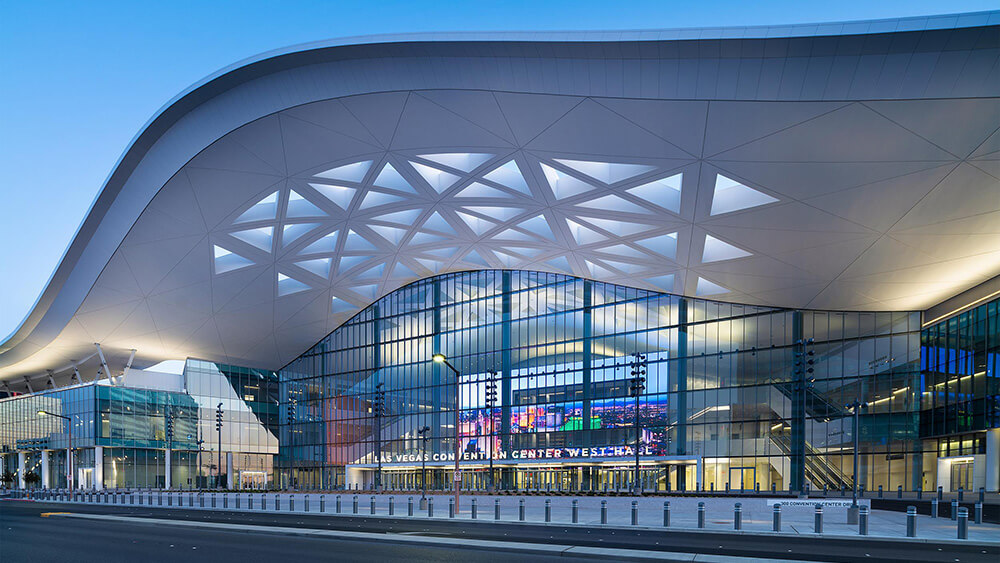
The Wall Street Journal ranked the Las Vegas Convention Center at No. 1 overall in its list of the top 30 U.S. convention centers.
The Wall Street Journal’s recent ranking of the top 30 U.S. convention centers used criteria generally understood as key to site selection: exhibition space, meeting rooms, total space, distance from the airport, hotel availability, meal price, arts/entertainment, food availability, and walkability.
The rankings were weighted 70 percent toward the size and quality of the convention center and 30 percent towards destination factors — density of food-service establishments and arts-and-entertainment venues relative to the local population of the area; the walkability of the area surrounding the convention center; the average cost of a meal in the city; and the number of pleasant days in 2022 (average temp between 55 and 85 degrees and negligible precipitation).
Not surprisingly, the Las Vegas Convention Center came in first for overall ranking, and the city’s Venetian Convention & Expo Center and Mandalay Bay Convention Center came in third and seventh, respectively, in overall ranking. Rounding out the top 10 were McCormick Place (2); San Diego Convention Center (4); Orange County Convention Center (5); Georgia World Congress Center (6); Phoenix Convention Center (8); Seattle Convention Center (9); and Kay Bailey Hutchison Convention Center (10).
The ranking weighting system the Journal used meant that even if a convention center had a high ranking in terms of its surroundings, if it didn’t hit the marks in terms of facility size and amenities, it fell lower on the list — for example, the Henry B. Gonzalez Convention Center in San Antonio scored second out of the 30 centers on the list in terms of city and surroundings but came in 23rd in overall ranking.
The sources the Journal used for the rankings were online data from the centers themselves; CoStar; Business Travel News’ Corporate Travel Index 2023; Walk Score; National Oceanic and Atmospheric Administration data (presumably for weather); and Google Maps.
I found two things curious about the Journal article. One has to do with the rankings: A center’s proximity to a dry cleaner was part of the ranking system. Personally, I’ve attended conventions for more than three decades and I can’t ever recall looking for a dry cleaner. Perhaps it was a consideration so that male attendees could find a convenient place to have their dress shirts pressed? If that’s the thinking here, it seems a little dated, since the dress code for many conferences today is more business casual.
But what really stood out to me is how the story demonstrated once again the invisibility of the meeting planner role. While the Journal cited such sources as the Events Industry Council and quoted from a spokesperson for the Las Vegas Convention and Visitors Authority to share economic impact numbers, no event organizers were interviewed for the story. Three professors from different schools of hospitality management weighed in, but no conference organizer — as in the professionals who actually decide on the convention centers to host events — was quoted.
Ending the article is a quote from Jay Kandampully, a professor of service management and hospitality at Ohio State University’s College of Education and Human Ecology: “We don’t remember the room that we slept in,” he told the Journal about attending a convention. “But we remember the people who created an experience.”
One may think: Oh, that’s where event planners are getting the credit, but no. Kadampully was referring to “a friendly and well-prepared customer-service staff” at the venue. Yes, friendly and helpful facility staff certainly contribute to a positive experience, but it’s planners who curate that experience.
“Another thing that makes a convention space successful, experts say,” according to the article, “is the way it facilitates interaction between people.” Absolutely: There are physical spaces that do a better job than others of fostering those connections. But it’s how the events and activities are intentionally designed around those spaces by creative event organizers that seals the deal.
We focus on the partnership between convention centers and organizers in creating safe and welcoming experiences in our upcoming September/October issue cover story. Stay tuned.
Michelle Russell is editor in chief of Convene.
